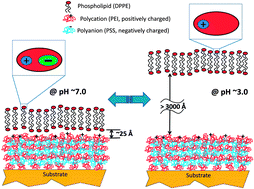Polyelectrolyte multilayers as a platform for pH-responsive lipid bilayers†
Abstract
A robust and simple method for the preparation of pH-responsive lipid membranes is reported. Polymeric cushions to support a lipid bilayer were obtained by performing layer-by-layer deposition of a polycation (polyethylene imine [PEI]) and a polyanion (polystyrene sulfonate [PSS]) on quartz, with PEI as a capping layer. Subsequently, a model membrane was obtained by depositing a DPPE bilayer using Langmuir–Blodgett and Langmuir–Schäfer technique. Structural characterization using Neutron Reflectivity revealed that the separation distance between the polymeric cushion and the DPPE bilayer can be reversibly adjusted by varying the pH of the aqueous environment. These observations were further supported by Electrochemical Impedance Spectroscopy measurements. Molecular dynamics simulations suggest that coulombic forces play a key role in affecting the separation distances between the polymeric support and the lipid bilayer. Similar pH-dependent behavior was also recorded for a DPPC bilayer. We believe that this novel system offers great potential for fundamental biophysical studies of membrane properties decoupled from the underlying solid support.


 Please wait while we load your content...
Please wait while we load your content...